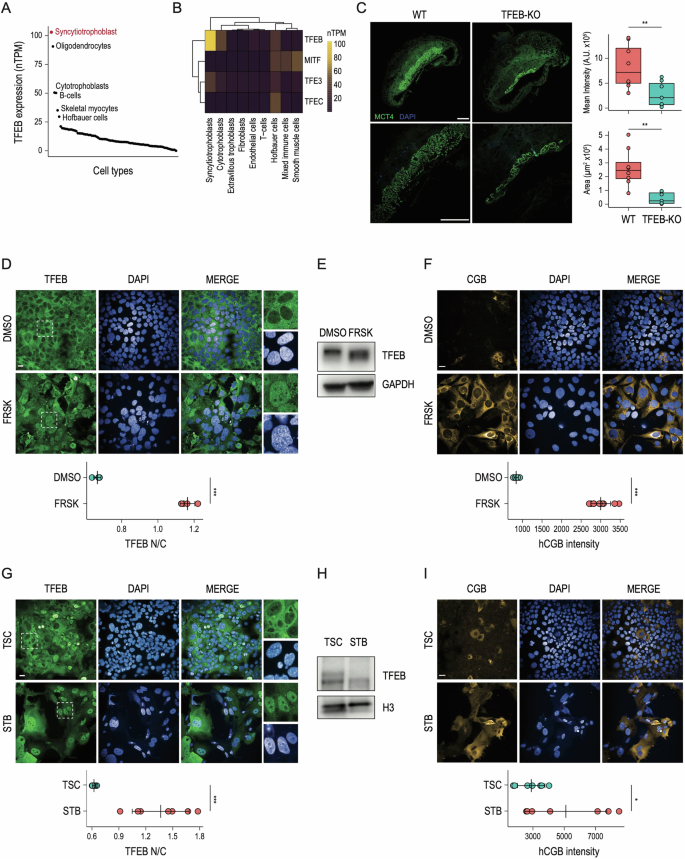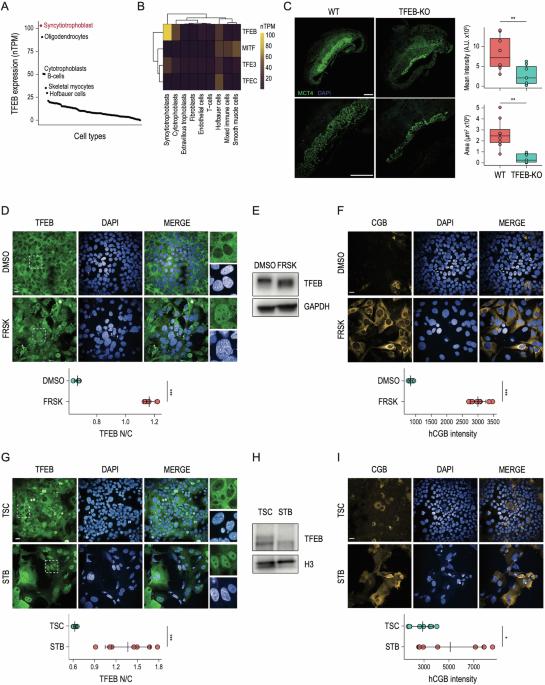TFEB controls syncytiotrophoblast formation and hormone production in placenta
IF 13.7
1区 生物学
Q1 BIOCHEMISTRY & MOLECULAR BIOLOGY
引用次数: 0
Abstract
TFEB, a bHLH-leucine zipper transcription factor belonging to the MiT/TFE family, globally modulates cell metabolism by regulating autophagy and lysosomal functions. Remarkably, loss of TFEB in mice causes embryonic lethality due to severe defects in placentation associated with aberrant vascularization and resulting hypoxia. However, the molecular mechanism underlying this phenotype has remained elusive. By integrating in vivo analyses with multi-omics approaches and functional assays, we have uncovered an unprecedented function for TFEB in promoting the formation of a functional syncytiotrophoblast in the placenta. Our findings demonstrate that constitutive loss of TFEB in knock-out mice is associated with defective formation of the syncytiotrophoblast layer. Indeed, using in vitro models of syncytialization, we demonstrated that TFEB translocates into the nucleus during syncytiotrophoblast formation and binds to the promoters of crucial placental genes, including genes encoding fusogenic proteins (Syncytin-1 and Syncytin-2) and enzymes involved in steroidogenic pathways, such as CYP19A1, the rate-limiting enzyme for the synthesis of 17β-Estradiol (E2). Conversely, TFEB depletion impairs both syncytial fusion and endocrine properties of syncytiotrophoblast, as demonstrated by a significant decrease in the secretion of placental hormones and E2 production. Notably, restoration of TFEB expression resets syncytiotrophoblast identity. Our findings identify that TFEB controls placental development and function by orchestrating both the transcriptional program underlying trophoblast fusion and the acquisition of endocrine function, which are crucial for the bioenergetic requirements of embryonic development.


TFEB 控制胎盘中合胞滋养细胞的形成和激素分泌
TFEB是一种属于MiT/TFE家族的bHLH-亮氨酸拉链转录因子,通过调节自噬和溶酶体功能在全球范围内调节细胞代谢。值得注意的是,小鼠体内 TFEB 的缺失会导致胚胎死亡,这是由于胎盘的严重缺陷与异常血管化和由此导致的缺氧有关。然而,这种表型背后的分子机制仍然难以捉摸。通过将体内分析与多组学方法和功能测定相结合,我们发现了 TFEB 在促进胎盘中功能性合胞滋养细胞形成方面前所未有的功能。我们的研究结果表明,基因敲除小鼠中 TFEB 的组成性缺失与合胞滋养层的缺陷形成有关。事实上,我们利用体外合胞化模型证明,TFEB 在合胞滋养细胞形成过程中会转位到细胞核中,并与关键胎盘基因的启动子结合,这些基因包括编码合胞化蛋白(Syncytin-1 和 Syncytin-2)的基因和参与类固醇生成途径的酶,如 CYP19A1,它是合成 17β 雌二醇(E2)的限速酶。相反,TFEB 的缺失会损害合胞滋养细胞的合胞融合和内分泌特性,表现为胎盘激素的分泌和 E2 的产生显著减少。值得注意的是,恢复 TFEB 的表达可重置合胞滋养细胞的特性。我们的研究结果表明,TFEB 通过协调滋养细胞融合的转录程序和内分泌功能的获得来控制胎盘的发育和功能,这对于胚胎发育的生物能量需求至关重要。
本文章由计算机程序翻译,如有差异,请以英文原文为准。
求助全文
约1分钟内获得全文
求助全文
来源期刊

Cell Death and Differentiation
生物-生化与分子生物学
CiteScore
24.70
自引率
1.60%
发文量
181
审稿时长
3 months
期刊介绍:
Mission, vision and values of Cell Death & Differentiation:
To devote itself to scientific excellence in the field of cell biology, molecular biology, and biochemistry of cell death and disease.
To provide a unified forum for scientists and clinical researchers
It is committed to the rapid publication of high quality original papers relating to these subjects, together with topical, usually solicited, reviews, meeting reports, editorial correspondence and occasional commentaries on controversial and scientifically informative issues.
 求助内容:
求助内容: 应助结果提醒方式:
应助结果提醒方式:


